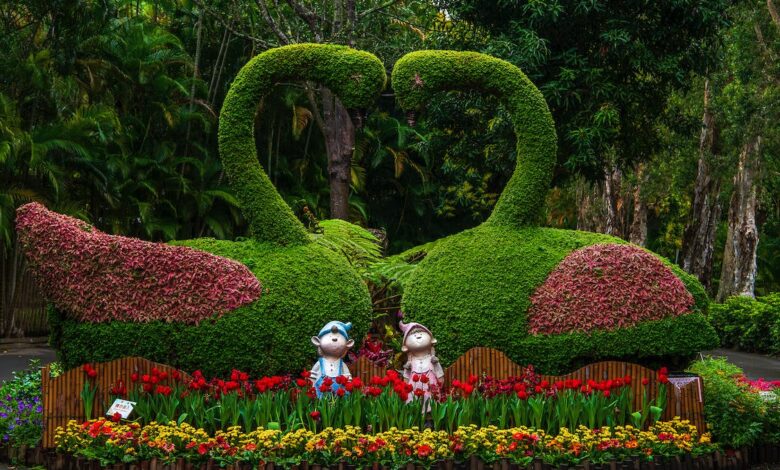14 most clever gardening tips and ideas

Introduction
14 most clever gardening tips and ideas is an art and a science, and mastering the craft involves employing clever tips and innovative ideas that go beyond the traditional approaches. Here’s a comprehensive guide to 14 of the most ingenious gardening techniques that can elevate your garden’s health and beauty:
1. Companion Planting:
Companion planting isn’t just about coexistence; it’s about fostering mutually beneficial relationships among plants. For example, planting aromatic herbs like rosemary or sage alongside cabbage can deter pests and enhance the flavor of the vegetables. Researching compatible plant combinations helps create a balanced and thriving garden ecosystem.
2. Vertical Gardening:
Utilizing vertical space isn’t just a necessity; it’s a design opportunity. Vertical gardens aren’t limited to trellises; they include stacked planters, wall-mounted containers, and even repurposed structures like old ladders or pallets. Growing upwards optimizes space while adding visual appeal to any garden.
3. DIY Seed Tape:
Crafting seed tapes isn’t just a time-saving technique; it’s an efficient way to ensure proper seed spacing. Using biodegradable materials like newspaper or paper towels, create strips with evenly spaced seeds attached with a paste made of flour and water. These tapes simplify the sowing process, especially for smaller seeds that are hard to handle individually.
4. Eggshell Fertilizer:
Eggshells offer more than just nutrients; they serve as natural pest deterrents. When crushed and scattered around plants, they create a barrier that deters pests like slugs and snails. Additionally, as they decompose, they enrich the soil with calcium, a crucial nutrient for plant growth and root development.
5. Rainwater Harvesting:
Collecting rainwater isn’t just about conservation; it’s a sustainable practice that benefits both plants and the environment. Installing rain barrels or cisterns allows gardeners to store rainwater, reducing dependency on municipal water sources. Rainwater, being free of chlorine and rich in nutrients, provides a natural and cost-effective way to hydrate plants.
6. Mulching:
Mulching isn’t just about aesthetics; it’s a vital component of soil health. Organic mulches like straw, leaves, or wood chips regulate soil temperature, retain moisture, and suppress weed growth. The gradual decomposition of mulch also enriches the soil with essential nutrients, promoting a healthy and fertile environment for plants.
7. Pruning Techniques:
Pruning isn’t just about shaping plants; it’s about maintaining their health and vigor. Understanding the specific pruning needs of different plants—whether it’s removing dead or diseased branches, shaping for aesthetics, or encouraging new growth—plays a pivotal role in promoting plant growth and overall garden aesthetics.
8. Container Gardening:
Container gardening isn’t just for urban spaces; it’s a versatile method suitable for any location. Containers come in various sizes, shapes, and materials, allowing for creative gardening solutions. Whether it’s repurposing old barrels or using decorative pots, container gardening offers flexibility and convenience for cultivating a variety of plants.
9. Upcycled Garden Décor:
Upcycling in the garden isn’t just about sustainability; it’s an opportunity to showcase creativity. Repurposing items like old tires, pallets, or even kitchen utensils as planters or garden decorations not only adds character to the garden but also reduces waste and contributes to an eco-friendly environment.
10. Integrated Pest Management:
Integrated pest management isn’t just about eradicating pests; it’s about maintaining a balanced ecosystem. Using natural pest repellents like neem oil, introducing beneficial insects, or practicing crop rotation and companion planting helps manage pests without the need for harsh chemicals, preserving the garden’s biodiversity.
11. Crop Rotation:
Crop rotation isn’t just about changing plant locations; it’s a method to prevent soil depletion and minimize pest problems. Rotating crops annually among different plant families helps balance soil nutrients, reduces the build-up of pests and diseases, and promotes healthier plants with higher yields.
12. DIY Compost:
Composting isn’t just about waste reduction; it’s a way to create nutrient-rich soil amendment. Layering organic materials like kitchen scraps, yard waste, and dried leaves in a compost bin initiates the decomposition process, yielding a nutrient-dense compost that enriches the soil and enhances plant growth.
13. Herb Spiral Gardens:
Herb spirals aren’t just visually appealing; they create microclimates that cater to diverse plant needs. Utilizing their multi-tiered structure, gardeners can grow a variety of herbs with varying sunlight and moisture requirements in a confined space, maximizing both efficiency and aesthetics.
14. Moon Gardening:
Moon gardening isn’t just folklore; it’s a practice rooted in observation and belief. Adhering to lunar phases for planting, pruning, and harvesting aligns gardening activities with cosmic rhythms. While scientifically unproven, many gardeners find this practice intriguing and claim positive outcomes in plant growth and productivity.
Conclusion
Implementing these 14 clever gardening tips and ideas not only transforms the garden into a thriving sanctuary but also encourages a deeper connection with nature and a more sustainable approach to cultivation.




